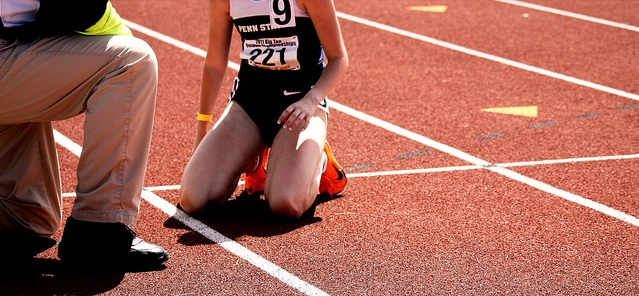The problem with a blog is that some great articles get buried in the graveyard that we call an Archive.

But most of the time, that information is still really helpful! (check out SR’s archive here)
I’ve received a lot of questions and requests (mostly from a survey of my newsletter readers) about what type of articles you’d like to see here, the resources you want me to offer, and other random questions.
Today’s article is going to answer the questions I got multiple times. If you have more running questions, just join my private list below and participate in the survey that I regularly send out.
Ready? Let’s go!
“Can you offer a running form analysis service?”
There was a time when I considered doing this. It would be fairly simple:
- Upload a clip of yourself running to YouTube
- I review it and offer suggestions on how to improve
The service does seem to be in high demand. In fact, it was the #1 most requested service/resource that I add to Strength Running.
But I started to think about how my advice would look to each individual runner and unfortunately, 90% of the advice would be the same.
Good running form isn’t that hard and you don’t have to become a Pose Method accredited coach (or whatever). Stick to the basics:
- Increase your cadence to roughly 170-180 steps per minute
- Land with your foot underneath your body, as opposed to “reaching” out with your foot and over-striding
These two adjustments will solve the vast majority of bad running form issues!
- Keep your back tall with a slight forward lean. No slouching or leaning from the waist.
- Try to land on your midfoot, though a slight heel strike (I’m a moderate heel striker myself) or “proprioceptive heel strike” isn’t necessarily bad
- Keep your arms at a roughly 90 degree angle (though this will vary) and try not to swing them across your chest
That’s about it! There are of course nuances and slight improvements that you can make, but most runners don’t need to get bogged down in the minutiae of tweaking their running form too much.
In fact, research has shown that consciously trying to change your running form can decrease your running economy – or in other words, when you try to alter your form, you become more inefficient.
A better way to improve your form is to observe the first two pieces of advice above and just run a lot. Your body will decide its most efficient form.
So while a form analysis service would be a service that I know would sell, I can’t do it with a clear conscious. The science isn’t there to confirm that it would help you – so I won’t do it.
“I need more information on injury prevention!”

Injury-free running – the nirvana of distance runners everywhere. When I was in college I loved playing the “if you had 3 wishes from a genie, what would they be?” game. They were:
- A bank account that never goes down from $1 billion
- The ability to fly
- The ability to train as hard as I want without getting hurt
Now that I’m older and wiser, I realize that wish #3 is cheating and takes the fun out of smart training. But I’d still love the first two wishes – so if I have any Genie readers, please email me.
Luckily Strength Running is chock-full of injury prevention advice. Your first stop is to check out the injury prevention category page. There are currently 48 articles with several videos to help you stay injury free.
I really believe I’ve written 98% of what you need to know regarding injury prevention. If you can’t find what you’re looking for just let me know and I’ll make it happen for you. I know there are several topics I haven’t discussed.
For more, join our free injury prevention course here.
Or, check out Strength Running’s flagship program Injury Prevention for Runners.
“Do you have training plans and analyses?”
Yes I do! Most stock training plans aren’t customizable, they’re inflexible, and they don’t include the necessary ancillary work (like strength exercises, flexibility drills, and injury prevention routines to help you stay healthy) so I can’t recommend them.
One exception is Run Your BQ, which has marathon-specific training plans (and Out-Season plans) with the extra work you need plus the ability to ask questions via our monthly live video chats.
That’s why I offer personal training plans (called the PR Race Plan) that are 100% custom to each individual athlete. They’re focused on your running history, injury background, goals, and current fitness level.
They’re the most popular service on Strength Running and to date, hundreds of runners have taken advantage of the opportunity.
I also have a training analysis option called a Plateau Buster. You’ll get a detailed breakdown of your training: what you’re doing right and what you can improve, with a cheat sheet of injury prevention advice and an example week of training that I think would help.
This service is perfect for runners who would like me to look over their training and give them an instant upgrade and suggestions for improvements.
The PR Race Plan and Plateau Buster aren’t for everyone. After creating hundreds of custom plans and training critiques, I’ve found that these runners are committed, interested in improvement, and passionate about running. If you don’t care much about running or have no goals then I don’t recommend them.
Paleo, Post-Run Routines, Books and More!

I can’t answer every single question from the survey I sent to my private list, but I want to help as many as possible. The feedback I got – and continue to get – is incredible; thank you for helping out the SR community!
Let’s go through a quick Q&A on some of the one-off questions:
“I’d like more info on Paleo nutrition and how to use this diet when running!”
Good question! I’ve touched on this previously in a few articles:
- The Power of Diet for Runners: How to Eat for Endurance and Lose Weight Effortlessly
- The Runner’s Eating Guide: 9 Tips for Keeping Off the Pounds this Christmas
- Hacking the Perfect Runner’s Diet: Food Lessons from a Lifetime of Obsession
- Eat This, Not That: 7 Easy Paleo Alternatives for Runners
But in reality, I haven’t laid out a real paleo-specific diet plan that distance runners can use because I don’t think I have enough information to do that.
Instead, I highly recommend the book The Paleo Diet for Athletes: A Nutritional Formula for Peak Athletic Performance. It has everything you need to eat 80% Paleo while being a successful distance runner.
We also cover this in our Nutrition Q&A with Anne Mauney MPH, RD. Download the two-part audio seminar here.
“Do you have any suggestions for running and training books?”
I have a ton – and an entire page dedicated to the books and programs I recommend. Check out the Runner’s Library I have for the best running books.
If you had to read just 2-3 books, I’d choose Run Faster by Brad Hudson and Matt Fitzgerald for training guidance, Born to Run by Chris McDougall for inspiration and background info on barefoot running, and In Defense of Food by Michael Pollan for the best look at diet I’ve ever seen.
“What about stretching and what to do after you run. What do you recommend?”
First, I don’t really recommend static stretching at all. It hasn’t been shown to offer any benefit to distance runners and can even lead to an injury if you stretch cold muscles before you run. But if you enjoy it, then you can do some static stretching after you finish running.
Instead, I recommend a dynamic warm-up and a strength-focused warm-down. Here’s what you can do after you finish your run:
- Standard Core Routine
- ITB Rehab Routine
- Myrtl Routine
- Cannonball Routine
- Mattock Warm-up
- Tomahawk Workout
If you start doing 1-2 of these routines every day, your injury rate is going to plummet. Plus, you’ll just feel better during your runs!
“Can you write about runners you’ve trained, their successes and personal stories?”
This is something that I’m trying to do more of because I think it’s a huge inspiration. So far, I’ve featured eight runners who have improved tremendously and are a serious source of motivation for all of us.
- How Terry Negative Split the Boston Marathon
- Meet Lydia: A Mom of 4 Who Lost 80 Pounds and Changed her Life with Running
- All Star Profile: Lisa Gonzales
- How Mark Ran a 16 Minute Marathon PR (despite thinking it was “beyond impossible”)
- How Ryan Beat ITBS and PR’d by 46 Minutes
- How Andy Improved his 5k and had his Wife Notice his Muscles
- How Rob Got Out of a Rut and PR’d Without Trying
- How Sam Went from DNF to a 2nd Place Age Group Finish
It’s beyond an honor to be a small part of these runner’s successes. Each athlete makes writing SR a pleasure and a truly rewarding experience for me.
Thanks to everyone on my private list who submitted their feedback to the survey – I really appreciate it! If you want to be able to shape the content of Strength Running, just sign up here or in the blue box below. You’ll also get a bunch of freebies only available to my newsletter readers (I spoil them like that).